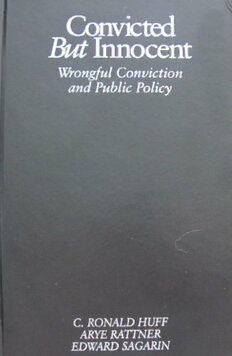
Convicted But Innocent: Wrongful Conviction and Public Policy PDF
Preview Convicted But Innocent: Wrongful Conviction and Public Policy
Convicted but Innocent: Wrongful Conviction and Public Policy C Ronald Huff Convicted But Innocent Convicted But Innocent Wrongful Conviction and Public Policy C. RONALD HUFF ARYE RATTNER EDWARD SAGARIN I SAGE Publication s } International Educational and Professional Publisher Thousan d Oaks London New Delhi Copyright © 1996 by Sage Publications, Inc. All rights reserved. No part of this book may be reproduced or utilized in any form or by any means, electronic or mechanical, including photocopy- ing, recording, or by any information storage and retrieval system, without permission in writing from the publisher. For information address: SAGE Publications, Inc. 2455 Teller Road Thousand Oaks, California 91320 E-mail: [email protected] m SAGE Publications Ltd. 6 Bonhill Street London EC2A 4PU United Kingdom SAGE Publications India Pvt. Ltd. M-32 Market Greater Kailash I New Delhi 110 048 India Printed in the United States of America Librar y of Congress Cataloging-in-Publicatio n Data Huff, C. Ronald. Convicted but innocent: Wrongful conviction and public policy / authors, C. Ronald Huff, Arye Rattner, Edward Sagarin, p. cm. Includes bibliographical references and index. ISBN 0-8039-5952-4 (cloth: acid-free paper). ISBN 0-8039-5953-2 (pbk.: acid-free paper). 1. Judicial error—United States. 2. False imprisonment—United States 3. Criminal justice, Administration of—United States. I. Rattner, Arye. II. Sagarin, Edward, 1913-1986. III. Title. KF9756.H84 1996 364.1'092'273—dc20 95-41748 This book is printed on acid-free paper. 97 98 99 10 9 8 7 6 5 4 3 2 Sage Project Editor: Christina Hill This book is dedicated to the memory of our friend and colleague, Professor Edward Sagarin, whose ideas and encouragement contributed greatly to this book and to our lives; and to the convicted innocents, whose cause he championed. C.R.H. A.R. Content s Foreword ix SIMON DINITZ Acknowledgments xvii Introduction xxi 1. With Apologies to the Prisoner 1 Defining the Convicted Innocents 10 Where Doubt Remains 13 Declared Innocent, and Still Incarcerated 16 2. Causes Celebres 21 A Nineteenth-Century Case: The Dreyfus Affair 24 The Scottsboro Boys 28 The Lindbergh Baby Kidnapping 29 The Sad Saga of Isidore Zimmerman 32 Randall Dale Adams: Injustice in Dallas 33 "Ivan the Terrible," or a Terrible Case of Mistaken Identity? 46 3. How Could This Have Happened ? The Causes and Prevalence of Wrongful Conviction 53 How Does It Happen? 66 Eyewitness Error 66 Prosecutorial and Police Misconduct and Errors 70 Plea Bargaining 73 Community Pressure for Conviction 75 Inadequacy of Counsel 76 Accusations Against the Innocent by the Guilty 77 Criminal Records 79 Race as a Factor 80 4. What Did They Really See? The Problems of Eyewitness Identification 83 Psychological Factors 87 Systemic Factors 93 Societal and Cultural Factors 98 Conclusion 104 5. False Confessions, Miranda Notwithstandin g 110 The Bradley Cox Case 123 6. Wrongful Conviction and Public Policy What Can Be Done? 142 Crime Control Versus Due Process 143 What Is the Meaning of Wrongful Conviction? 146 Reducing the Incidence of Wrongful Conviction 150 Identifying and Exonerating Convicted Innocents 153 Compensating and Reintegrating Convicted Innocents 155 Capital Punishment: The Irreversible Error 160 References 162 Cases 167 Index 169 About the Authors 179 Forewor d HHj Of the many troubled social institutions in American life—includ- WKm ing public education, welfare, health, and the family—none is in greater difficulty than the criminal justice system. Many billions of federal dollars have been spent on criminal justice agencies and programs since the introduction of the Law Enforcement Assistance Administration in the late 1960s in the "war on crime" stemming from persistent public pressure for greater personal safety. Astronomic sums have been allocated to upgrade law enforcement equipment; to go on-line in this computer age so that law enforcement agencies can more efficiently collect, record, maintain, and share information; to improve forensic science; to recruit and train additional qualified personnel (more than 100,000 new police officers alone in the latest crime bill, 1994-1995); to reduce racial, gender, and ethnic biases in the system; to speed up the criminal justice process; to rewrite the criminal codes and impose draconian sentences on those convicted of drug offenses; to revive the death penalty; to move toward ix
